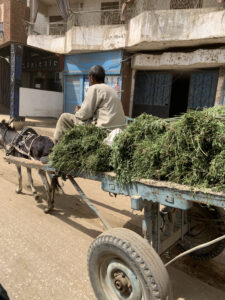 The tiny speck on the horizon, distorted in the shimmering heat of early morning, grew larger and morphed into a wobbly, tented roadside stand, half way between Aswan and Abu Simbel, Egypt, deep in the Sahara Desert. Our van had left Aswan about 4:00am. It was now 6:00am and the sun was a blazing disc even at that hour. We pulled up to the open air tent and got out to stretch our legs. The place was a glorified side-of-the-road refreshment stand, its canvas roof flapping in the breeze, the bright green and red stripes faded to gray and pink.
The tiny speck on the horizon, distorted in the shimmering heat of early morning, grew larger and morphed into a wobbly, tented roadside stand, half way between Aswan and Abu Simbel, Egypt, deep in the Sahara Desert. Our van had left Aswan about 4:00am. It was now 6:00am and the sun was a blazing disc even at that hour. We pulled up to the open air tent and got out to stretch our legs. The place was a glorified side-of-the-road refreshment stand, its canvas roof flapping in the breeze, the bright green and red stripes faded to gray and pink.
‘My god, this looks like a scene out of ‘Thunder Road’. Where the hell are we?’ one of my passengers asked, referencing the film about a world without water. He shaded his eyes from the blinding sun and scanned the endless flat horizon. Nothing but sand. Not a hillock, dune, rock, blade of grass, or a mouse, just an enormous expanse of nothingness spread out before us. The land was arid, parched and seamless, like the sky above. “The land of nothingness,”he said, “the end of the road, where death goes to die.” We stood at the edge of the road, a ribbon of mushy asphalt unraveling into the distance, south toward Sudan in central Africa. At 6:00am this was an accurate description. By 5:00pm, the place would change in ways we could not imagine that morning.
“Hello,” I said to the fellow behind the L-shaped counter. “What’s the name of this place?”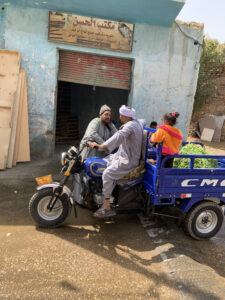
“Name?”, he looked bewildered. “Never gave it a name.” He was the only non-Egyptian working and spoke perfect English. He thought a second then said, “Go 10 more feet south and you’re closer to Sudan than Aswan so we’re halfway. Maybe I oughta call it Halfway Cafe.” On the counter was a display case stacked with Snickers, M&Ms, Gummi bears, and Turkish Delight alongside Wrigley’s spearmint gum and Camel cigarettes, the only type of camel that could survive out here.
“What would you like? We’ve got tea, coffee, water and Pepsi. A bunch of candy bars, gum, cigarettes and some of these sesame covered sweet sticks.” He pointed to a jar full of long bread sticks soaked in honey and sprinkled with tiny seeds. “The Egyptians love’em and they’re good with a coffee.”
“A coffee and a stick, thanks.,” I answered and asked where he was from. “Los Angeles. Names Matt Pritchard” At that moment a jalopy passing by on the highway backfired and Matt jumped and ducked a little. A second or two later, recovered, he stretched out his hand to shake mine. “Welcome to my cafe in the middle of nowhere!” His hand swept across the covered open terrace shaded by the faded canvas fluttering over a scatter of tables and chairs, the furniture painted shades of glossy red, purple and orange. A few tourists sat drinking tea or water, nibbling on sesame somethings.
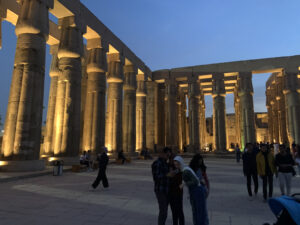 “How long have you been out here?”, I asked. “This seems pretty remote for a guy from Los Angeles. Isn’t it a bit boring sometimes?”
“How long have you been out here?”, I asked. “This seems pretty remote for a guy from Los Angeles. Isn’t it a bit boring sometimes?”
“Well sir, there’s a lot goes on here, a lot. You oughta see this place in the afternoon. It hops, it really jumps. I love it.” A patron asked for a can of soda, Matt rolled up his sleeve and plunged his arm into a water-filled cooler to fetch a cold Pepsi. Matt’s right hand was missing two fingers and the forearm had what looked like 2 bullet hole scars, pink and faded. A tattoo, gray and smudged, was on the back of what was left of the hand and read ‘IRAQ 1st Brigade 1991’. He handed the young man the bottle, took the cash and turned back to me. “Yeah, I know it’s nuts but I love it here. It’s exactly what I need. It’s perfect”
The drive to Abu Simbel was another two hours. The landscape stayed the same, flat and featureless, until we neared the Sudan border where the land became hilly, the earth redder. The Nile River, blue and shimmering, coursed through the parched land. We had driven a couple hundred miles this morning to the spot where Ramses the Great in 1300 BC had built the massive and monumental sculptures of himself, the temple today called Abu Simbel.
Abu Simbel, 3300 years ago, marked the southern border of Ramses II’s empire, as it marks Egypt’s southern border today. Hundreds of miles south of his capital Qantir on the Nile Delta, the size and wonder of the monument was a visible sign to Ramses’ enemies from the south that this temple on the Nile River was the beginning of his empire, that he was in charge, that this was his land and his alone.
The temple is 12 stories high, originally cut deep into the red sandstone of a cliff on the shore of the Nile River, with 4 colossal statues of Ramses II himself. Each statue is over 7 stories tall, the four of them towering over the river. The statues were intended to intimidate visitors and enemies alike, not welcome them. They stood in all their grandeur for centuries, guarding the entrance to Egypt, perhaps frightening all who sailed up the Nile.
But as the British poet Shelley reminds us in ‘Ozymandias’, even the great and mighty have their day and then are swept away by time. Except for part of the statues’ heads, the site was covered by desert sand and lay forgotten for centuries, until the 1800s when the site was rediscovered by a Swiss explorer and again regained world attention as a tourist sight. 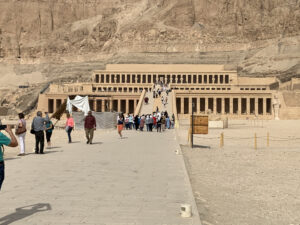
By itself, the story of the temple is fascinating, a symbol of empire, ego, power, and glory 33 centuries ago, but a new chapter in history was added in the 1960s. As the Aswan High Dam was being built hundreds of miles to the north, the level of the Nile River began to rise and threatened to inundate the border region, covering Abu Simbel. Nations around the world worked with Egypt to save the temple and from 1964 to 1968 cut it into countless blocks and raised it 200 feet to where it sits today. The engineering feat is mind boggling but adds to the legend of the place.
Today, as they did eons ago, the statues dwarf the visitors, making them look small and insignificant by comparison, exactly what Ramses the Great had intended his enemies to feel. He ruled for over 60 years, built countless other monuments to himself, and lived into his 90s, quite an accomplishment, considering the average Egyptian in 1300 BC lived only into their mid 30s.
The sun moved higher and the heat of the desert winds exhausted all of us. We headed back to Aswan and two hours later stopped again at what we now called the Sahara Cafe. The place had been transformed. It teemed with people, like a local bar on a Saturday night in a Boston neighborhood, ‘Cheers’ in the desert. Tables and chairs had been pushed aside and the locals were singing and dancing, their work day finished. The elderly sat in chairs to the side, gossiped, smoked and laughed, the younger ones danced and sang on the open terrace floor, children darting through the crowd, chasing after one another.
A couple of tour buses had stopped and there was a line at the single restroom in the back. Matt tended the bar and shouted in Arabic at his friends who motioned for him to join them on the terrace. As we entered, he waved with his three fingered hand, and went back to serving ice cream and Pepsis. The place was jumping with life and vitality, but where the locals came from was a mystery. They had simply shown up, risen out of the sand, or so it seemed.
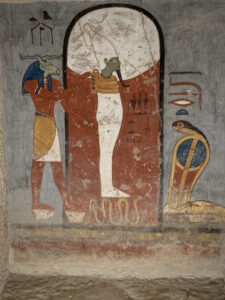 The bus patrons complained bitterly about the long restroom wait and the poor cell phone coverage, the eternal download times and the heat of the day, while the locals celebrated the end of a 12 hour work day. After a quick coffee and a nod to Matt, we took off for Aswan.
The bus patrons complained bitterly about the long restroom wait and the poor cell phone coverage, the eternal download times and the heat of the day, while the locals celebrated the end of a 12 hour work day. After a quick coffee and a nod to Matt, we took off for Aswan.
The cafe disappeared in the rear view mirror. The barren landscape filled the width of windshield and stretched to the horizon, flat and seamless. Perfect in its own way.
